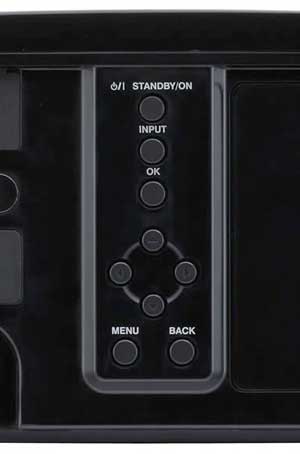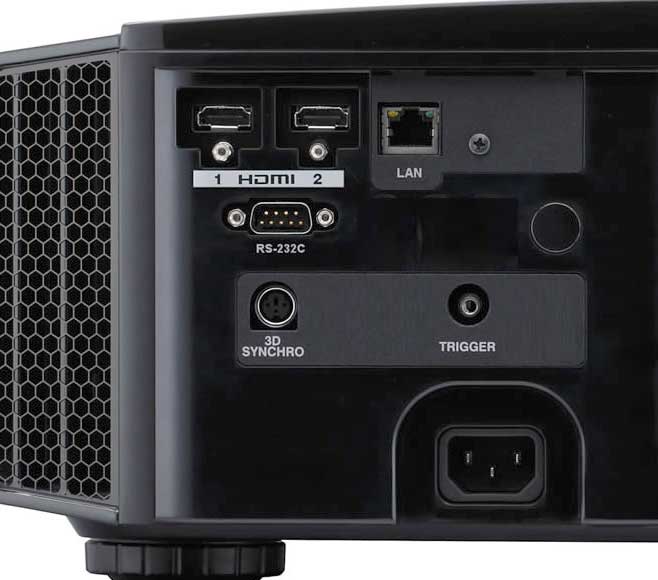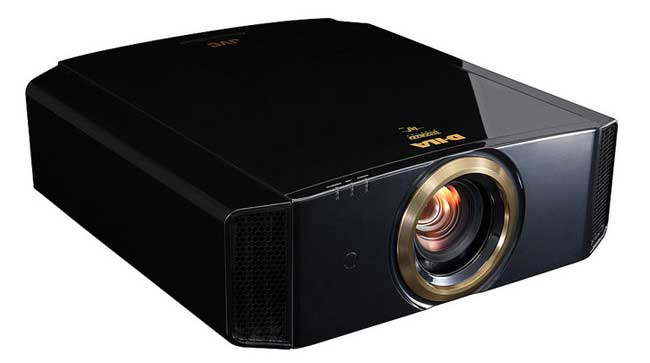DLA-RS400U AND DLA-X550 PROJECTOR REVIEW - HARDWARE TOUR: Overview, Control Panel, Inputs and Connectors
This page does not include info on the remote control or menus. That page will be added sometime after the initial publication of this RS400U review. Menus are essentially very similar to previous JVCs, especially its predecessor, the RS4910. This
link will take you to info and photos of those JVC menus.
DLA-RS400U Hardware - Overview
This RS400 looks like a couple of generations of predecessors, and in fact, much is the same. For openers, there’s the 2:1 power zoom lens which is center mounted. There are no manual focus or zoom controls, nor are there any controls for the vertical and horizontal lens shift that the projector has, making the shiny black RS400 look nice and clean, almost sleek but actually a bit muscular looking due to large exhaust vents on the front, which, I should note, allow for rear shelf mounting. There’s a tiny button on the bottom front for manually opening the lens cover, which normally opens at power up, and closes upon shutdown. This is primarily for maintenance. There are three LED indicators on the top front edge, for the usual power, temp and lamp functions.
The control panel is on back along with all the inputs and other connectors. We’ll go over both shortly.
The RS400 has four screw thread adjustable feet, just in case you are using on a shelf or table top rather than ceiling mounting it. There are two intakes for the cooling system on the back (and one on the bottom). Be sure to allow the rear intakes to “breathe” if shelf mounting. (I have a very old JVC RS20 (a forerunner to the RS500) I use rarely because I have so many projectors to “play with.” In my last house I had that JVC rear shelf mounted, so for me, those feet did come in handy.) Naturally the lamp can be replaced without un-mounting the projector (if ceiling mounted). There are IR sensors for the rather excellent remote, located both front and rear, which combined with the remote’s inherent range (officially 7 meters (about 22 feet), allows the remote to work well is larger home theaters.
Control Panel

Control panel on the rear of the RS400
Nothing surprising here, and the same as the previous generation of JVC projectors. As you can see from the image, Located in the center of the back of the RS400, from the top: Power/Standby – Press once to turn on, or twice to power down.
Below that is the Input button for selecting the source. Then comes the Enter button, which JVC labels OK.
Right below that are the four arrow keys for navigating the menus. They are laid out in a typical diamond formation.
That leaves only the bottom two buttons: On the left, is the Menu button, while to its right, is the Back button which takes you back up a level in the menus.
Bottom line, a very basic control panel, but one well laid out. Of course the far more featured remote control offers up all that and far more.
Inputs and Connectors
One thing I’m noticing this year is that some manufacturers, including JVC, are finally getting rid of a number of older style inputs, as HDMI now dominates. Composite video, and S-video, and sometimes analog computer inputs are vanishing. Most can be fed through HDMI with an adapter. I’m sure there must be someone out there wanting to plug their Sony Betamax into a modern projector, and I’m pretty certain there are work arounds to make that happen.
Back to the task at hand: The RS400 lacks a standard analog computer input, which has been true of its predecessors as well. The higher end JVCs have until now offered one, but again, HDMI now rules, so even the RS400’s big brothers no longer have an HD15 connector for analog PC use.

From the back left top:
First up are the pair of HDMI inputs – they are the latest: HDMI 2.0, with HDCP 2.2 making them Blu-ray HD compatible. They do not support MHL for working with streaming sticks like Roku or Amazon Fire, but that’s not overly surprising for a couple of reasons: No built in speaker or audio out, so if you plugged in such a stick, you wouldn’t have audio.
Next over is RJ45 Network connector – which is there for remote command and control.
Right below the HDMI inputs is an RS232 serial port – used for old style command and control, so you have some choice. A couple inches to the right is the rear IR sensor for the remote control.
On the next row, is a DIN connector for either the old, PK-EM1 3D emitter, or the newer, RF PK-EM2 emitter (they are optional). Then to it’s right is the 12 volt screen trigger, for controlling a motorized screen, or (far less likely, an anamorphic lens sled, since the RS400 has lens memory).





